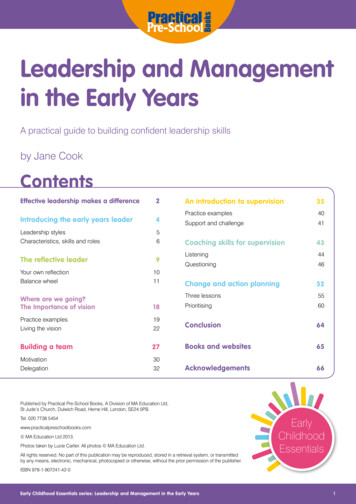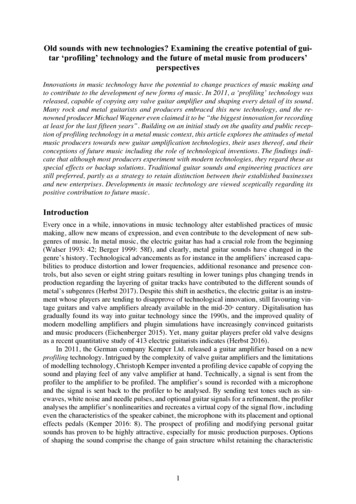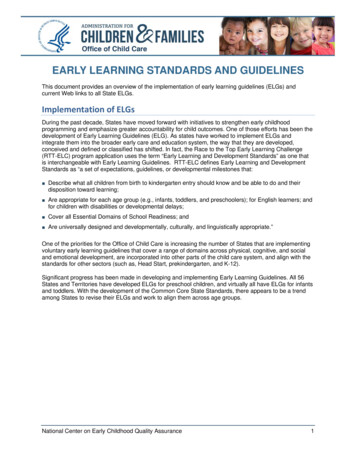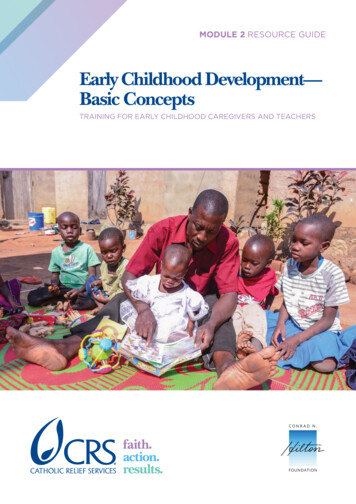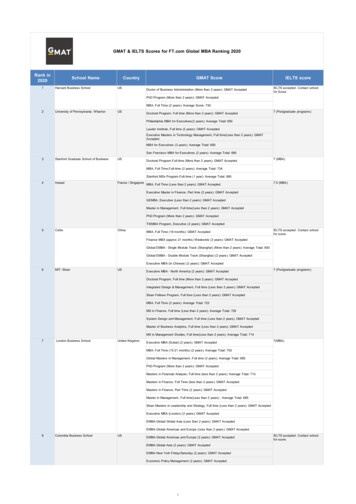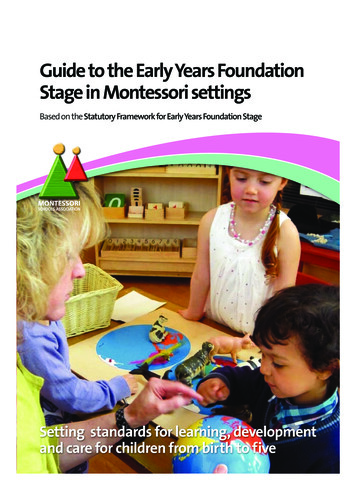
Transcription
EYFS Guide 2013:Layout 111/10/1209:31Page 2Guide to the Early Years FoundationStage in Montessori settingsBased on the Statutory Framework for Early Years Foundation StageMONTESSORISCHOOLS ASSOCIATIONSetting standards for learning, developmentand care for children from birth to five
EYFS Guide 2013:Layout 111/10/1209:32Page 3MONTESSORISCHOOLS ASSOCIATION
EYFS Guide 2013:Layout 111/10/1209:32Page 4PrefaceWelcome to the second edition of thisguide. The first edition, published withthe support of the Department forChildren, Schools and Families, hasproved invaluable to people working inMontessori schools and settings in reinforcing the ways inwhich the Montessori approach to education shares theunderlying principles of the Early Years Foundation Stage(EYFS). The guide has also been extensively used byinspectors and local authority officers as well as in trainingMontessori and other teachers. The aim of this secondedition is to show how Montessori practices relate to therevised EYFS, which is implemented from September 2012,and includes the learning and development requirements aswell as those for welfare and assessment.The principles underlying the EYFS are ones with whichMontessorians are very familiar and which they endorseenthusiastically. We acknowledge that every child is unique;that children learn to be strong and independent throughpositive relationships; that they learn and develop well inenabling environments; and that they develop and learn indifferent ways and at different rates. Such themes lie at theheart of good Montessori practice and it has been mostencouraging to find that nearly 90% of Montessoripreschools are regarded by inspectors as being outstandingor good. It is also a tribute to the hard work of those whowork in Montessori settings.Our thanks again go to Barbara Isaacs for her work on thisguide. We hope that you will find it both useful andinformative. The Montessori Schools Association is onceagain pleased to be able to demonstrate the continuingrelevance of Maria Montessori’s work in educating youngchildren in the twenty-first century.Dr Martin BradleyNational Chair, Montessori Schools AssociationContents2nd edition published August 2012 by Montessori St. Nicholas CharitySuite One and Two, University House, 11-13 Lower Grosvenor Place,London SW1W 0EXTel: 0207 828 7740www.montessori.org.ukemail: head-office@montessori.org.ukForeword by Barbara Isaacs3Introduction31. Exploration of the overarching principles72. Learning and Development requirements113. Assessment404. The safeguarding and welfare Requirements42Contacts and useful information45
EYFS Guide 2013:Layout 111/10/1209:32Page 5ForewordBy Barbara IsaacsSgive settings the opportunity to manage their action plan forimprovement whilst engaging the whole team in discussionon how to develop and extend their practice. There is strongevidence that those settings which committed to theaccreditation also achieved high grading during Ofstedinspections. 88% of the Montessori settings inspectedbetween the introduction of the EYFS in 2008 and thepresent have achieved Outstanding or Good judgements intheir inspections.ince the publication of the original Guide to theEarly Years Foundation Stage in MontessoriSettings in the spring of 2008, the MontessoriSchools Association in Britain has grown strongerand larger with over 650 schools in membershipand over 4000 individual members. Montessorians, withsupport from the Montessori St. Nicholas Charity, haveasserted a stronger voice within the national early yearscommunity. The Guide was the first ever opportunity tohave Montessori practice endorsed by the then Departmentfor Education and Skills who funded the original design andprinting of the document. Copies were distributed to LocalAuthorities and to Ofsted inspectors and made available toMontessori settings and students. Over the past four yearsthe Montessori St. Nicholas Charity continued to make thepublication available not only to newcomers to Montessori,but also to our colleagues in the early years community.This success endorsed Montessori colleges’ discussions withProfessor Cathy Nutbrown about the significant contributionMontessori provision, alongside Steiner education, makes tothe diverse early years family. It also reflects parents’continued interest in selecting Montessori education as theoptimum introduction to learning for their children. Therecent successful bid by the Montessori St. Nicholas Charityto deliver parenting classes in Camden, London furtherdemonstrates the growing acceptance and recognition ofthe Montessori approach as current, valid and relevant to thelives of children and their families. The charity is alsoexploring ways of introducing parenting classes to the widerMontessori community, thus enabling Montessoripractitioners to extend their support for the children and theThe publication of the Guide coincided with the launch ofthe Montessori Evaluation and Accreditation Board whohave, since the spring of 2008, accredited over 130Montessori settings committed to ongoing improvements intheir practice. The scheme has a strong following andreaccreditations, begun in 2012, now entail two visits and2
EYFS Guide 2013:Layout 111/10/1209:32Page 6“88% of the Montessori settings inspected between theintroduction of the EYFS in 2008 to the present have achievedOutstanding or Good judgements in their inspections.”children in our care. The new EYFS document givesMontessorians the opportunity to express their beliefs thatin the early years children’s spontaneous learning is ofparamount importance. Such learning needs to be nurturedby sensitive and well informed observers who prepare richindoor and outdoor learning environments which activelysupport children’s play and exploration and lead to creativethinking. Whilst preparing children for life Montessorieducation gives young children the tools for positive socialinteractions, independence and confidence which enablethem to make smooth transitions to primary school and themany other social situations they will encounter later.families who attend their setting. This effective partnershipis one of the key principles of the positive relationshipstheme within the EYFS.In commissioning this second edition of the EYFS Guide theMontessori St. Nicholas Charity demonstrate their on goingsupport for the Montessori Schools Association and theirmembers.Using this document we hope to provide the Montessoricommunity with the opportunity to reflect on their practicewithin the context of the EYFS as based on the key principlesunderpinning the Montessori ethos and pedagogy. Wewould encourage practitioners to share the content of thisbooklet with their team and discuss the changes and theirimplications to their practice. As the title of the publicationindicates, it is a guide to good practice: its implementationwill depend on each individual setting.Barbara IsaacsAugust 2012The new statutory framework builds on the good practiceencouraged in the original document. Its core themesremain. If we, as practitioners, engage with the UniqueChild, Positive Relationships and Enabling Environments andthe extended principles, we should be able to deliver highquality learning and development opportunities for theI would like to thank Dr. Martin Bradley, Anne-Marie True,Dawn Nasser and Ursula Nerre for their patience, support andguidance in preparation of this booklet. Special thanks go tothe children and staff from Rose House Montessori Schoolwhose photographs make this guide come alive anddemonstrate current high quality Montessori practice.3
EYFS Guide 2013:Layout 111/10/1209:32Page 74
EYFS Guide 2013:Layout 111/10/1209:32Page 8INTRODUCTIONIntroductionIn the introduction to the Statutory Framework theDepartment for Education identifies four aims for the EYFS: quality and consistency in all early years settings, so thatevery child makes good progress and no child gets leftbehind; a secure foundation through learning and developmentopportunities which are planned around the needs andinterests of each individual child and are assessed andreviewed regularly; partnership working between practitioners and withparents and/or carers; and equality of opportunity and anti-discriminatory practice,ensuring that every child is included and supported.These aims are further underpinned by the four key themesand principles as identified in the original EYFS. They arenow firmly embedded in all good early years practice andfrom the very beginning gave Montessorians theopportunity to demonstrate that the Montessori practice of“following the child” requires a favourable environment andempathetic and knowledgeable practitioners who nurturechildren’s learning and development.In line with the Statutory Framework this guide aims toexplain Montessori practice and is organised as follows:1. Exploration of the overarching principles2. Learning and development requirements3. Assessment4. The safeguarding and welfare requirements5
EYFS Guide 2013:Layout 111/10/1209:32Page 96
EYFS Guide 2013:Layout 111/10/1209:32Page 101. EXPLORATION OF THE OVERARCHING PRINCIPLES1: Exploration of theoverarching principlesA Unique childPositive RelationshipsEvery child is a unique child who is constantly learning andcan be resilient, capable, confident and self-assuredChildren learn to be strong and independent throughpositive relationshipsPractitioners:Positive relationships are understand and observe children warm, loving and foster a sense of belongingAs Montessorians we need to understand both Montessori’sperspective of children’s development and be able tointerpret it in context of current theory. This developmentalunderstanding needs to be reflected in the evaluation ofobservations and be translated into effective and relevantplanning in support of individual learning and development.As Montessorians we need to nurture each individual childin a harmonious and peaceful environment which fosterspositive sense of belonging. sensitive and responsive to children’s needs,feelings and interests support development of positive sense ofidentity and cultureOur observations of children should guide us in getting toknow each child and his/her unique qualities andcharacteristics and learning dispositions.We need to trust each individual child in his/her efforts to‘construct an individual’. supportive of individual efforts andindependenceWe need to provide a learning environment which enableseach child to grow in his/her independence according totheir unique needs and efforts. identify additional needsWe must have the skills to meet each child’s individual needsand be able to find guidance and support to nurture theiradditional needs. consistent in setting clear boundariesPractitioners need to create a favourable environment whichoffers each child freedom of movement, choice, socialinteractions and engagement. This type of freedom sets asits limits the wellbeing and respect for oneself, each otherand the environment. The child’s need for independence isencouraged leading to autonomy and initiative. keep children safeWe must ensure through our policies, procedures andpractice that children in our care are always safe. value and respect children and families equallyWe must ensure through our policies, procedures andpractice that all children and their families are always valuedand respected. stimulatingThe favourable environment reflects the individual needsand interests of the children and ensures that it entices andengages the child in stimulating and challenging activities,giving each child the opportunity to develop his/her uniquepotential. built on key person relationshipsThe role of the key person is to provide an effective andmeaningful communication link between the child, thesetting and his/her family whilst ensuring that the childcontinues to make positive relationships with all the childrenand adults in the setting.7
EYFS Guide 2013:Layout 111/10/1209:32Page 111. EXPLORATION OF THE OVERARCHING PRINCIPLES rich learning opportunities through play andplayful teachingEnabling environmentsChildren learn and develop well in enabling environments,where their experiences respond to their individual needsand where there is a strong partnership betweenpractitioners and parents/carers.The Montessori activities and learning materials arecomplemented and extended by a wide range of activitieswhich support and meet the individual needs of childrenand provide rich learning opportunities for play and work.The adults know each child well and are able to ensure thatthe children’s play and learning are relevant and appropriateto their unique patterns of development and learningdispositions.Enabling environments value: all people learningIn line with Montessori’s beliefs the favourable environmentis respectful of the people and resources which enablechildren’s individual efforts and learning to develop accordingto their unique characteristics. It offers a continuousprovision of activities during which children engagespontaneously in the two and a half – three hour ‘work cycle’which will include individual or shared learning sometimesguided by a more knowledgeable peer or by the teacher. support for children to take risks and exploreMontessori pedagogical principles rest on the belief thatchildren need to learn to do things by and for themselves.Through initial teaching the child acquires skills whichsupport his/her independence, enable challenging activitiesand facilitate risk taking and exploration, such as helping inpreparation of a snack by cutting fruit with a knife, orbuilding a tower which is taller than themselves. Whilstexploration, challenge and risk are encouraged they arealways supported by effective risk assessment andappropriate health and safety policies.Enabling environments offer: stimulating resources, relevant to all thechildren’s cultures and communitiesThe Montessori favourable environment is carefully planned,prepared and maintained to offer accessibility, consistencyand continuity of learning. Montessori activities andequipment provide young children with a firm foundation totheir development by enabling learning in small,manageable yet interesting steps, nurturing theirindependence and by respecting all cultures andcommunities; children are encouraged to see themselves as‘citizens of the world’.Learning and DevelopmentChildren develop and learn in different ways. Theframework covers the education and care of all children inearly years provision, including children with specialeducational needs and disabilities.Practitioners teach children by ensuring challenging, playfulopportunities across the prime and specific areas of learningand development.8
EYFS Guide 2013:Layout 111/10/1209:32Page 121. EXPLORATION OF THE OVERARCHING PRINCIPLESCharacteristics of effective early learning are defined byDevelopment Matters (2012, p.5) as:engagement, motivation and thinking, each one of thesecharacteristics resonates with our understanding ofchildren’s play and work in Montessori favourableenvironments as facilitated by the ‘work cycle’ and thefreedom with responsibility which children learn anddevelop. Montessorians are urged to explore Montessori’sown writing relating to human tendencies and sensitiveperiods and consider them in context of the qualities ofeffective early learning. Use of the material presented inDevelopment Matters (2012, pages 6 and 7) would furtherenhance team discussions and clarify the Montessoriperspective on effective early learning in the context of theUnique Child, Positive Relationships and EnablingEnvironments. Development Matters can be downloadedfree of charge from www.early-education.org.uk Playing and exploring - engagementFinding out and exploring, playing with what they know,being willing to have a go. Active learning – motivationBeing involved and concentrating, keeping trying, enjoyingachieving what they set out to do. Creating and thinking critically - thinkingHaving their own ideas, making links, choosing ways to dothings.Whilst as Montessorians we may question the definitions ofChildren’s learning and development as set out in the Statutory Framework is now defined in sevenareas of learning, each area with its own unique aspects. The areas of learning are organised as followsin the revised EYFS:PRIME AREASAreas of Learning and DevelopmentAspectsCommunications and Language Listening and attention Understanding SpeakingPhysical Development Moving and handling Health and self-carePersonal, Social and Emotional Development Making relationships Self confidence and self awareness Managing feelings and behaviourSPECIFIC AREASAreas of Learning and DevelopmentAspectsLiteracy Reading WritingMathematics Numbers Shapes space and measureUnderstanding the World People and Communities The world TechnologyExpressive Arts and Design Exploring and using media and materials Being imaginative9
EYFS Guide 2013:Layout 111/10/1209:32Page 1310
EYFS Guide 2013:Layout 111/10/1209:32Page 142: Learning and developmentrequirementsThis element of early years practice defines whatpractitioners must do to ensure the positive learning anddevelopment of all children and help them prepare for thenext stage of their learning.the EYFS. Available from www.early-education.org.ukA know how guide: The EYFS progress check at age two.Available from www.ncb.org.uk/ey/peertopeersupportParent’s Guide to the Early Years Foundation StageFramework: exciting times ahead for you and your child.Available from: ence It is expected that the setting engages parents and carers,working in partnership with them in nurturing theirchildren’s learning and development and this would includeeffective support for children with special education needs.The early learning goals: Whilst home languages are valued, children in a settingmust be encouraged to develop good level of English duringthe Early Years Foundation Stage.All areas of learning are interconnected; in the early years wellplanned learning experiences will meet several learning goalsand will spark children’s interest and enthusiasm forlearning, support well-being and sense of belonging. In allareas of learning and development the practitioners workwith children and their families towards achieving the earlylearning goals by the time children reach the summer term inreception class or following their fifth birthday. At this time allchildren will be assessed using the statutory EYFS profile: seethe next section for more details. The three prime areas areparticularly crucial in promoting effective learning anddevelopment during the Early Years Foundation Stage. The key person is a significant link between the child, familyand support services. Play is seen as a key tool for learning in the early years.Purposeful play should be child initiated and child-led. Itshould be appropriately supported by practitioners whosensitively respond to the child’s emerging needs, interestsand different ways of learning. Progressively, and if thechild’s development allows, more adult-led activities shouldbe introduced to help children prepare for more formallearning in Year 1 of primary school.Prime areas The nursery team must be well qualified and the trainingand development needs of the staff members must beconsidered regularly to ensure quality learning experiencesfor children (see section 4: the Safeguarding and welfarerequirements).Communication and language development involvesgiving children opportunities to experience a rich languageenvironment; to develop their confidence and skill inexpressing themselves; and to speak and listen in a rangeof situations.To ensure that practitioners interpret the learning anddevelopment requirements appropriately they are guided toconsult the following resources, all available electronically freeof charge.Physical development involves providing opportunities foryoung children to be active and interactive; to develop theirco-ordination, control, and movement. Children must alsobe helped to understand the importance of physicalactivity, and to make healthy choices in relation to food andpersonal hygiene.Statutory Framework for the Early Years Foundation Stage:Setting the standards for learning, development and care forchildren from birth to five. This is the statutory guidancedocument which was used in preparation of the Guide to theEYFS in Montessori Settings (2nd edition, 2012). All settingsshould download it and print it off and keep it together withthe Guide and make it available to their staff. It can beaccessed on tionDetail/Page1/DFE-0023-2012Personal, social and emotional development involveshelping children to develop a positive sense of themselvesand others; to form positive relationships and developrespect for others; to develop social skills and learn how tomanage their feelings, to understand appropriatebehaviour in groups, and to have confidence in their ownabilities.Development Matters in the Early Years Foundation Stage:The non-statutory guidance material which supportspractitioners in implementing the statutory requirements of11
EYFS Guide 2013:Layout 111/10/1209:32Page 152. LEARNING AND DEVELOPMENT REQUIREMENTSCommunication and language developmentCommunication and language developmentListening and attentionDevelopment Matters guidelines on the expecteddevelopmental progression which will guide the child inworking towards the early learning goal in this area ofdevelopment and learningExamples of Montessori Practice or materials andresources which will help the child in achieving the EarlyLearning GoalTHE CHILDTHE CHILD16 to 26 months: listens to and enjoys rhythmic patterns in rhymes andstorieshas daily access to, and enjoys listening to andparticipating in nursery rhymes, songs and stories andmusical instruments enjoys rhymes and demonstrates listening by trying tojoin in with actions of vocalisationsis encouraged to join in and contribute when ready rigid attention – and may appear not to hear22-36 months:participates in the silence game which encourages focusedlistening listens with interest to the noises adults make when theyread stories recognises and responds to many familiar sounds, e.g.turning to a knock on the door, looking at or going to thedoorparticipates in two way conversations is given time torespond appropriately shows interest in play with sounds, songs and rhymesis encouraged to focus on presentations of new activities single channelled attention, can shift to a different task ifattention fully obtained – using child’s name helps focus30 to 50 months: listens to others one to one or in small groups, whenconversation interests them listens to stories with increasing attention and recall joins in with repeated refrains and anticipates key eventsand phrases in rhymes and stories focuses attention – still listens or does, but can shift ownattention is able to follow directions if not intently focused on ownchoice of activity40 to 60 months: maintains attention, concentrates and sits quietly duringappropriate activity two-channelled attention – can listen and do for shortspanEarly Learning Goal as described in the EYFS; by the end of the Reception year the child should be able to: listen attentively in a range of situations listen to stories, accurately anticipating key events and respond to what they hear with relevantcomments, questions and actions give their attention to what others say and respond appropriately, while engaged in another activity12
EYFS Guide 2013:Layout 111/10/1209:32Page 162. LEARNING AND DEVELOPMENT REQUIREMENTSCommunication and language developmentUnderstandingDevelopment Matters guidelines on the expecteddevelopmental progression which will guide the child inworking towards the early learning goal in this area ofdevelopment and learningExamples of Montessori Practice or materials andresources which will help the child in achieving the EarlyLearning GoalTHE CHILDTHE CHILD16 to 26 months:is given opportunities to demonstrate their understandingby following short conversations and non verbalinteractions selects familiar objects by name and will go and findobjects when asked, or identifies objects from a group. understands simple sentences, e.g. ‘Throw the ball’listens to instructions from adults and peers whichgradually become a routine as the child matures andsettles into the rhythm of daily life22-36 months: identifies action words by pointing to the right picture,e.g. ‘Who’s jumping?’ understands more complex sentences, e.g. ‘Put your toysaway and then we’ll read a book.’responds to questions from adults and friends understands, ‘who’, ‘what’, ‘where’ in simple questionse.g. Who’s that? What’s that? Where is?is able to follow complex instructions and respond to themappropriately as the child becomes more experienced andsettled in daily routines developing understanding of simple concepts,e.g. big/little30-50 months: understands use of objects, e.g. What do we use to cutthings? shows understanding of prepositions such as ‘under’, ‘ontop’ ‘behind’ by carrying out an action or selecting correctpicture responds to simple instructions, e.g. to get or put awayan object beginning to understand ‘why’ and ‘how’ questions40-60 months: responds to instructions involving a two-part sequence understands humour, e.g. nonsense rhymes, jokes able to follow a story without pictures or props listens and responds to ideas expressed by others inconversation or discussionEarly Learning Goal as described in the EYFS; by the end of the Reception year the child should be able to: follow instructions involving several ideas or actions answer ‘how’ and ‘why’ questions about their experiences and in response to stories and events13
EYFS Guide 2013:Layout 111/10/1209:32Page 172. LEARNING AND DEVELOPMENT REQUIREMENTSCommunication and language developmentSpeakingDevelopment Matters guidelines on the expecteddevelopmental progression which will guide the child inworking towards the early learning goal in this area ofdevelopment and learningExamples of Montessori Practice or materials andresources which will help the child in achieving the EarlyLearning GoalTHE CHILDTHE CHILD16 to 26 months: beginning to put two words together, e.g. ‘want ball’,‘more juice’has opportunities to listen attentively and demonstrateunderstanding of spoken and non-verbal language androutines responding verbally as language unfolds anddevelops use different types of everyday words including nouns,verbs and adjectives, e.g. banana, go, sleep, hotis supported in the development of spoken language by: beginning to ask simple questions modelling of spoken language beginning to talk about people and things that are notpresent appropriate use of language copies familiar expressions, e.g. ‘Oh dear’, ‘All gone’. extension of vocabulary in all areas of learning - usingconversations, books and stories as well as the threeperiod lessons22 to 36 months: uses language as a powerful means of wideningcontacts, sharing feelings, experiences and thoughts acknowledging the importance of the child’s homelanguage whilst supporting emerging use of thelanguage spoken in the nursery holds a conversation, jumping from topic to topic learns new words very rapidly and is able to use them incommunicating encouraging conversations encouraging telling of their own stories at everyopportunity , particularly during play, creative activitiesand when exploring activities in knowledge of the world uses gestures, sometimes with limited talk, e.g. reachestoward toy, saying ‘I have it’ uses a variety of questions, e.g. what, where, who encouraging questions uses simple sentences, e.g. ‘Mummy gonna work’ beginning to use word endings, e.g. going, cats30 to 50 months: beginning to use more complex sentences to linkthoughts, e.g. using and, because can retell a simple past event in correct order, e.g. wentdown slide, hurt finger uses talk to connect ideas, explain what is happeningand anticipate what might happen next, recall and relivepast experiences questions why things happen and gives explanationsusing question words, e.g. who, what, when, how uses a range of tenses, e.g. play, playing, will play, played uses intonation, rhythm and phrasing to make themeaning clear to others uses vocabulary focused on objects and people that areof particular importance to them14
EYFS Guide 2013:Layout 111/10/1209:33Page 182. LEARNING AND DEVELOPMENT REQUIREMENTSSpeakingCommunication and language development(continued)Development Matters guidelines on the expectedExamples of Montessori Practice or materials andresources which will help the child in achieving the EarlyLearning Goaldevelopmental progression which will guide the child inworking towards the early learning goal in this area ofdevelopment and learningTHE CHILDTHE CHILD builds up vocabulary that reflects the breadth of theirexperiencesappropriate use of language is a key focus in Montessorinurseries and children are always encouraged to expresstheir thoughts, ideas and feelings uses talk in pretending that objects stand for somethingelse in play, e.g. ‘This box is my castle’40 to 60 months: extends vocabulary, especially by grouping or naming,exploring the meaning and sounds of new words uses language to imagine and recreate roles andexperiences in play situations links statements and sticks to a main theme or intention uses talk to organise, sequence and clarify thinking,ideas, feelings, and events introduces a storyline or narrative in their playEarly Learning Goal as described in the EYFS; by the end of the Reception year the child should be able to: express themselves effectively, showing awareness of listeners’ needs use past and future forms accurately when talking about events that have happened or are to happenin the
the Montessori St. Nicholas Charity continued to make the publication available not only to newcomers to Montessori, but also to our colleagues in the early years community. The publication of the Guide coincided with the launch of the Montessori Evaluation and Accreditation Boar

